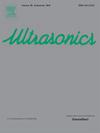相控阵方法产生导波,并采用V(z)法提取相速度
IF 3.8
2区 物理与天体物理
Q1 ACOUSTICS
引用次数: 0
摘要
本文的目的是研究用相控阵换能器代替经典单元件换能器的可能性,当应用V(z)方法获得样品的导模速度时,由此可以推导出弹性常数。研究了用相控阵换能器V(z)法产生和探测声导波的优点和注意事项。通过定义一个允许产生声场聚焦的延迟定律,表明可以以与使用几何聚焦(即球形或圆柱形)换能器类似的方式获得V(z)曲线。详细分析了各向异性衬底上激活阵列元素数量、焦距和频率值的选择对导模产生和探测的影响。首先,建立了使用相控阵换能器时获得的V(z)声特征模型。然后,为了说明相控阵参数的影响,讨论了单晶各向异性硅衬底上导模的产生和检测。结合相控阵换能器的V(z)方法可以产生和探测表面声波(SAW)、伪表面波(PSAW),甚至是掠过表面的准纵波(SSQLW)。在本研究中,我们还强调必须仔细注意相控阵换能器参数的选择与工作频率的结合,以避免V(z)曲线上的不稳定。本文章由计算机程序翻译,如有差异,请以英文原文为准。
Phased array approach to generate guided waves and extract phase velocities using the V(z) method
The aim of this paper is to investigate the possibility to use a phased array transducer instead of a classical single-element transducer when applying the V(z) method to obtain the guided mode velocities of a sample, from which elastic constants can de deduced. Thus it studies the advantages and precautions that should be taken for generating and detecting acoustic guided waves by the V(z) method with a phased array transducer. By defining a delay law allowing the generated acoustic field to be focused, it is shown that it is possible to obtain V(z) curves in a similar way as when using geometrically focused (i.e. spherical or cylindrical shape) transducers. A detailed analysis is presented to illustrate how the choices of the number of activated array elements, the focal distance and the frequency values, influence the generation and detection of guided modes on an anisotropic substrate. First, a model of the V(z) acoustic signature obtained when using a phased array transducer is developed. Then, in order to illustrate the influence of the phased array parameters, the generation and detection of guided modes on a single-crystal anisotropic silicon substrate are discussed. The interest of the V(z) method coupled with a phased array transducer to generate and detect the surface acoustic wave (SAW), pseudo-surface wave (PSAW), and even the surface skimming quasi-longitudinal wave (SSQLW) is thus demonstrated. In this study, we also highlight that careful attention must be paid to the choice of the parameters of the phased array transducer in combination with the working frequency to avoid instabilities on V(z) curves.
求助全文
通过发布文献求助,成功后即可免费获取论文全文。
去求助
来源期刊

Ultrasonics
医学-核医学
CiteScore
7.60
自引率
19.00%
发文量
186
审稿时长
3.9 months
期刊介绍:
Ultrasonics is the only internationally established journal which covers the entire field of ultrasound research and technology and all its many applications. Ultrasonics contains a variety of sections to keep readers fully informed and up-to-date on the whole spectrum of research and development throughout the world. Ultrasonics publishes papers of exceptional quality and of relevance to both academia and industry. Manuscripts in which ultrasonics is a central issue and not simply an incidental tool or minor issue, are welcomed.
As well as top quality original research papers and review articles by world renowned experts, Ultrasonics also regularly features short communications, a calendar of forthcoming events and special issues dedicated to topical subjects.
 求助内容:
求助内容: 应助结果提醒方式:
应助结果提醒方式:


